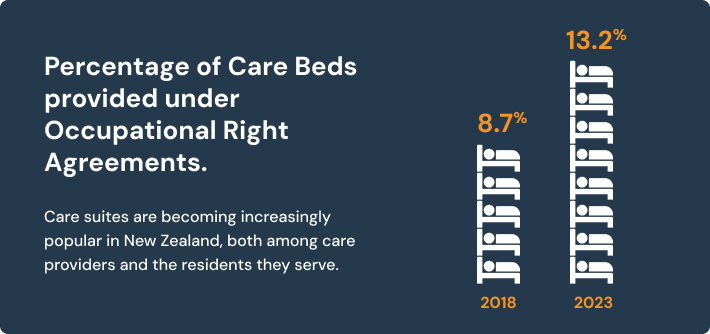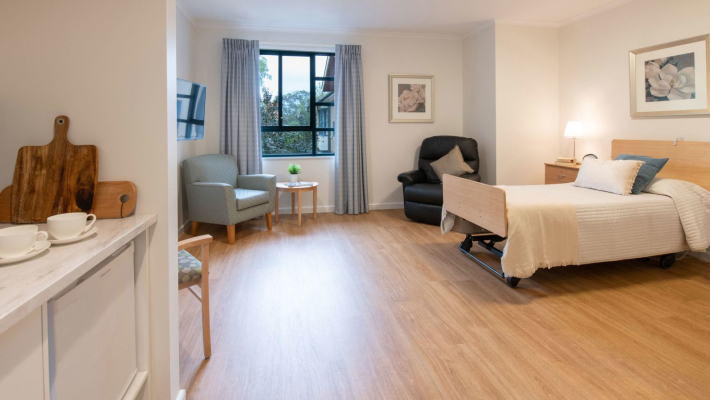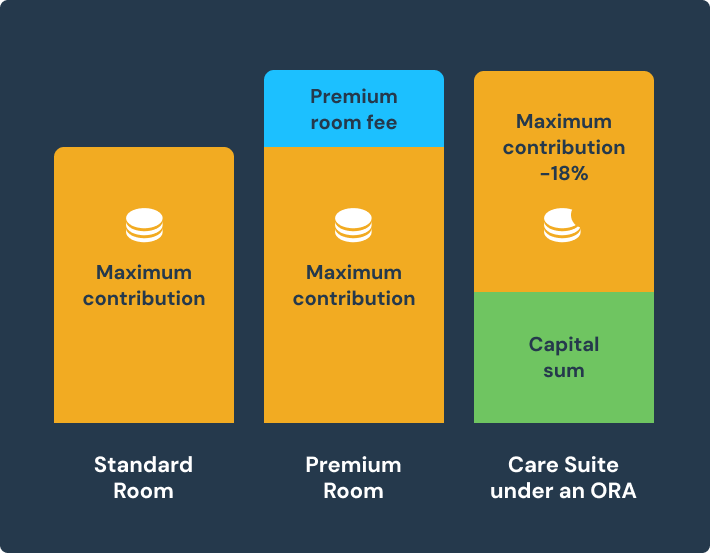
Care suites are a modern approach to aged care, combining comfort with support. Typically offered as studio or one bedroom apartments, they are designed to feel like home, with spacious interiors and ensuite bathrooms.
Anyone exploring care options for a friend or relative is likely to have come across the term "care suite."
Care suites are becoming increasingly popular in New Zealand, both among care providers and the residents they serve. The percentage of the nation’s care beds provided through care suite accommodation has risen from 8.7% in 2018 to 13.2% in 2023.

We answer eight of the most common questions people have when it comes to care suites.
1. How do care suites differ from other care accommodation options?
Care suites are a private studio or one bedroom apartment within a care facility.
They generally:
- Are spacious, with attractive and contemporary interiors
- Include an ensuite bathroom and a small kitchenette
- Come furnished with a hospital bed and modern, comfortable furniture. Residents are also welcome to bring their own furniture if it fits the space, such as a favourite chair.
In essence, living in a care suite feels much like living in your own private apartment, offering both comfort and a sense of independence.
2. What’s the difference between a care suite and a serviced apartment?
Typically, a serviced apartment allows a resident to live independently in a retirement village while receiving additional assistance with daily tasks, such as cooking, cleaning, laundry services, and tailored support, including personal care and medication administration. However, some serviced apartments may allow residents to remain in place if their needs progress, provided they meet the eligibility criteria for rest home or hospital level care.
Another term operators may use for a care suite is "care apartment."
3. Do you receive better care services in care suites compared to standard or premium rooms?
The type of accommodation should not impact the level of care you will receive. Care services are based on individual needs, not on the type of room or suite. The benefit of most care suites is that they cater to both rest home and hospital level care. This means that if you move in requiring rest home level care and your needs change over time, you will not need to move again if the care suite is dual purpose for hospital level care.
4. What are the costs of living in a care suite?
Residents typically occupy a care suite under what is known as an Occupation Right Agreement (ORA). This is the same type of agreement often signed by residents living independently in a retirement village.
To secure the accommodation, residents are required to pay an upfront capital amount. When they leave, this capital is refunded, minus a portion known as a deferred management (or exit) fee, which is typically around 20-30% of the capital amount and specified in the ORA.

A typical care suite includes space for a small kitchenette, some furniture, a bed or bedroom, and an ensuite bathroom.
5. How does the payment model for care suites differ from that for standard or premium rooms?
To understand how payment models work, it’s helpful to define certain terms:
- Capital sum: An upfront payment to secure an Occupation Right Agreement (ORA), allowing the resident to live in the accommodation for as long as they choose, though without legal ownership.
- Premium room: A room that incurs an additional charge for features not covered under the Age-Related Residential Care Agreement (ARRC), such as a larger room, ensuite, or a better view.
- Premium room fee: A daily fee for additional features in a premium room. This fee can vary widely, from $15 to over $100 depending on the room itself and care facility.
- Maximum contribution: The upper limit care homes can charge for rest home level care, as outlined in the ARRC Agreement, covering both accommodation and care.
- Government subsidies: Available if residents meet certain criteria, including asset and income thresholds, covering accommodation costs up to the cost of a standard room. Residents in a premium room pay the premium room fee privately.
The payment model for a care suite can be broken down into two parts:
Accommodation: Since residents have already paid a capital sum, they do not pay additional "premium room fees."
Care: Residents still pay separately for care services (e.g., nursing, doctor visits, medications) as outlined in the ARRC.
As residents in a care suite pay a capital sum for their accommodation, the maximum contribution is typically reduced by 18%* to reflect the covered accommodation portion.

Note: Speak with the care manager directly to confirm specific details, as operators may differ slightly in their policies.
6. What are the benefits of care suites?
Some of the main benefits of care suites include:
- Higher accommodation standards with additional space.
- Some care suites are suitable for couples to remain together.
- A known upfront accommodation cost prior to moving in.
- Some operators may allow residents to use the equity in an existing retirement village dwelling (managed by the same operator) toward a care suite, enabling a seamless transition.
7. What are the potential downsides of care suites?
- To move into a care suite, you generally need to be able to pay a capital contribution, usually from the sale of an existing retirement village or residential home.
- When you leave, a portion of the initial capital sum will be retained by the operator as the deferred management fee. If you are already residing in a retirement village, it is most likely that you will need to enter into a new ORA agreement, separate from the ORA and deferred management fee attached to your current retirement village home.
- If the resident requires a high level of care due to illness and is likely to need the care suite for only a short period, a premium room might be more suitable. However, speak with the provider, as depending on your situation, there may be an option to occupy the suite on a different contractual basis, such as paying a premium room fee.
8. Do you need to be a resident of an existing retirement village to access a care suite in that village’s care facility?
No, it’s not required. You can move into a care suite without having lived in an associated retirement village.
Care suites are redefining aged care by offering a blend of comfort, independence, and tailored support. As their popularity grows across New Zealand, understanding their unique features—such as private accommodation, transparent costs, and suitability for couples—can make navigating this decision easier for families. Exploring care suites with providers, asking questions, and considering personal needs will ensure you find the right fit.

